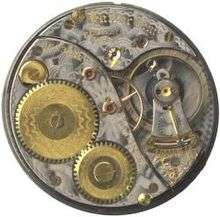Damaskeening

In horology, damaskeening is decorative patterning on a watch movement. The term damaskeening is used in America, while in Europe the terms used are Fausses Côtes, Côtes de Genève or Geneva Stripes. Such patterns are made from very fine scratches made by rose engine lathe using small disks, polishing wheels or ivory laps. These patterns look similar to the results of a spirograph or Guilloché engraving.
Damaskeening was first used in America around 1868-1869 by the U.S. Watch Co of Marrion and later spread to most other American watch manufacturers.
Two-tone damaskeening can be created by applying a thin plating of gold and then having the damaskeening scrape through the gold outer layer and into the nickel plate, or simply creating damaskeening on the gold layer. This creates patterns with two colors.
References
Complete Price Guide to Watches, by Cooksey Shugart, Tom Engle, Richard E. Gilbert, Edition 1998 (18th ed), ISBN 1-57432-064-5